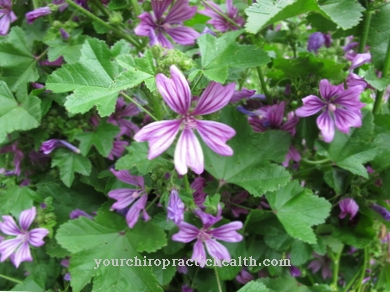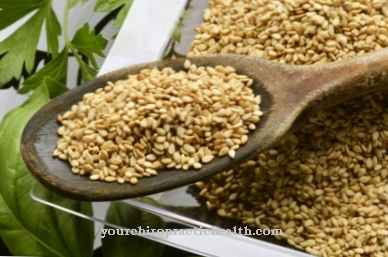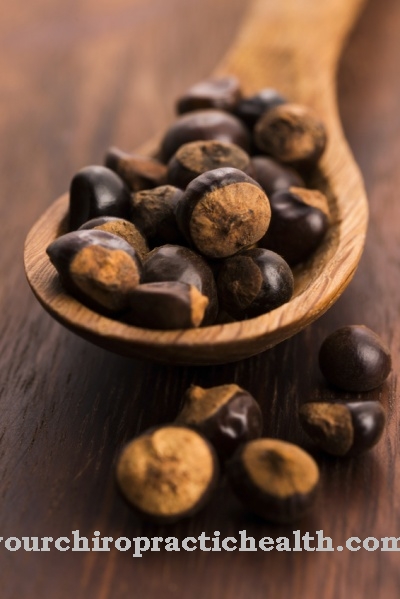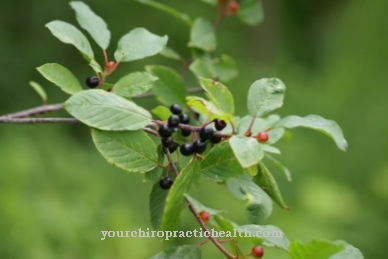Of the Ordinary spindle bush is also known by the name Ordinary peacock. It is a poisonous medicinal plant, the components of which are only used in homeopathic medicines and externally as an ointment.
Occurrence & cultivation of the common spindle bush

The deciduous, upright and widely branched shrub has dull, square branches with a gray-brown bark in cross section. The rod bush carries trugdolige inflorescences with a one to three centimeters long inflorescence stem. Each inflorescence contains two to six, sometimes nine, individual, bright pink flowers. The common spindle bush is also known under the name common eccentric cap, as the capsule fruits resemble the headgear of Catholic clergymen, the biretta.
It grows in bushes, on the edges of forests and roads or as an ornamental plant in gardens on nutrient-rich clay soils. The generic name Euonymus is a plant name that goes back to both the Greek and Latin languages and means "good" and "with a good reputation". This term is probably meant ironically because the poisonous effect of the spindle bush was already known in ancient times. The name Spindelstrauch goes back to the type of wood that can also be used for turning.
Effect & application
The common spindle bush has a diuretic, cardiac tonic, wound-healing, antiviral (herpes zoster, herpes simplex), dehydrating (diuretic), acaric (miticidal) and laxative effect. The plant is effective against headaches, liver damage, sore muscles, indigestion, biliary problems, closed shin injuries, scabies, lice and heart failure.
Homeopathy uses the poisonous medicinal plant in potentised medicines for headaches that are caused by liver damage, for symptoms of the liver and pancreas, bladder irritation and gall problems (strong cholagogue). These medicines are used under the scientific name Euonymus europaea in the form of globules with a potency of C12. In this potentised dilution, homeopathic medicines are harmless.
The seeds contain steroid glycosides (cardenolides), digitoxigenin, cardiac glycosides, triacetin, dyes, fatty oil, as well as the alkaloids caffeine, evonine and theobromine. Due to its ingredients, the common spindle bush has a digitalis-like effect: it increases the force of contraction of the heart "positively inotropic", reduces the heartbeat frequency "negatively chronotropic", slows down or impedes the conduction of excitation "negatively domotropic" and lowers the stimulus threshold of excitation formation "positive bathmotropic".
The bark contains bitter substances, phlobaphene and tannins. The leaves contain triterpenes. The fruits form fatty oil that is processed into ointments. In folk medicine, the common eccentric cone was made as a tea from the leaves for headaches. A tea made from the bark is diuretic and frees the body of toxins. However, these explanations are only of historical interest, since internal use is no longer permitted due to the highly toxic plant effects.
The common spindle bush was also used against dropsy. These types of application go back to the famous scholar from the Middle Ages, Hildegard von Bingen. Only knowledgeable herbalists used this product. Homeopathy offers good alternatives to the poisonous common ephemera. Aconitum napellus for headaches, Lycopodium clavatum for liver weakness, Carminativum, Hevert Digesto, Nux vomica, Magnesium chloratum, Colocynthis, Carbo vegetabilis, and Hepar-Hevert for various types of biliary complaints and dysfunction of the gastrointestinal tract.
Importance for health, treatment & prevention
All parts of the plant in the common ephemera are poisonous, so they must not be used in an unprocessed, natural way, but only in the form of finished preparations or homeopathic medicines. Consumption of the plant parts, especially the seeds and fruits, leads to vomiting, nausea, diarrhea and abdominal pain. The concentration of the toxic ingredients is particularly high there.
Consumption of approximately 36 fruits is described as a lethal dose, taking into account the height, weight and health of the person concerned. In a child, two seeds are enough to cause severe toxic symptoms. The common spindle bush should not be underestimated, which if consumed can also lead to kidney damage, drowsiness, circulatory collapse and liver swelling.
In the worst case, the consumption of the plant parts is fatal if heart rhythm disturbances (arrhythmias), paralysis of the masticatory muscles and airways as well as states of shock set in. The latency period is up to 18 hours, within which the aforementioned complaints can occur. The toxic effect is mainly due to the cardiac glycosides, which were previously used in conventional medicine for heart problems, but have now been replaced by thimble preparations (digitalis).
The ingredient Evonin develops insecticidal active ingredients and can be used as a powder against vermin, but it must never be inhaled. First aid measures are induction of vomiting and the allocation of activated charcoal. Large amounts of warm tea and laxatives can also prevent the toxic substances from entering the bloodstream. The basic principle is to keep the patient warm and calm.
Exercise is the wrong means because it stimulates the circulation and thus spreads the toxic substances more quickly. In the hospital, the doctor will do a gastric lavage, administer potassium permanganate, sodium sulfate and electrolyte substitution. If acidosis is present, sodium hydrogen carbonate (sodium bicarbonate) helps if the acid content is below an average of 7.35 (0 to 14).
Mucilaginosa reduces irritation in the gastrointestinal tract and benzodiazepines and barbiturates counteract cramps. In shock states, the sedative diazepam is administered intravenously. The function of breathing and kidneys is monitored. In the case of respiratory depression or paralysis of the respiratory organs, breathing is artificially supported.
















.jpg)
.jpg)



.jpg)






